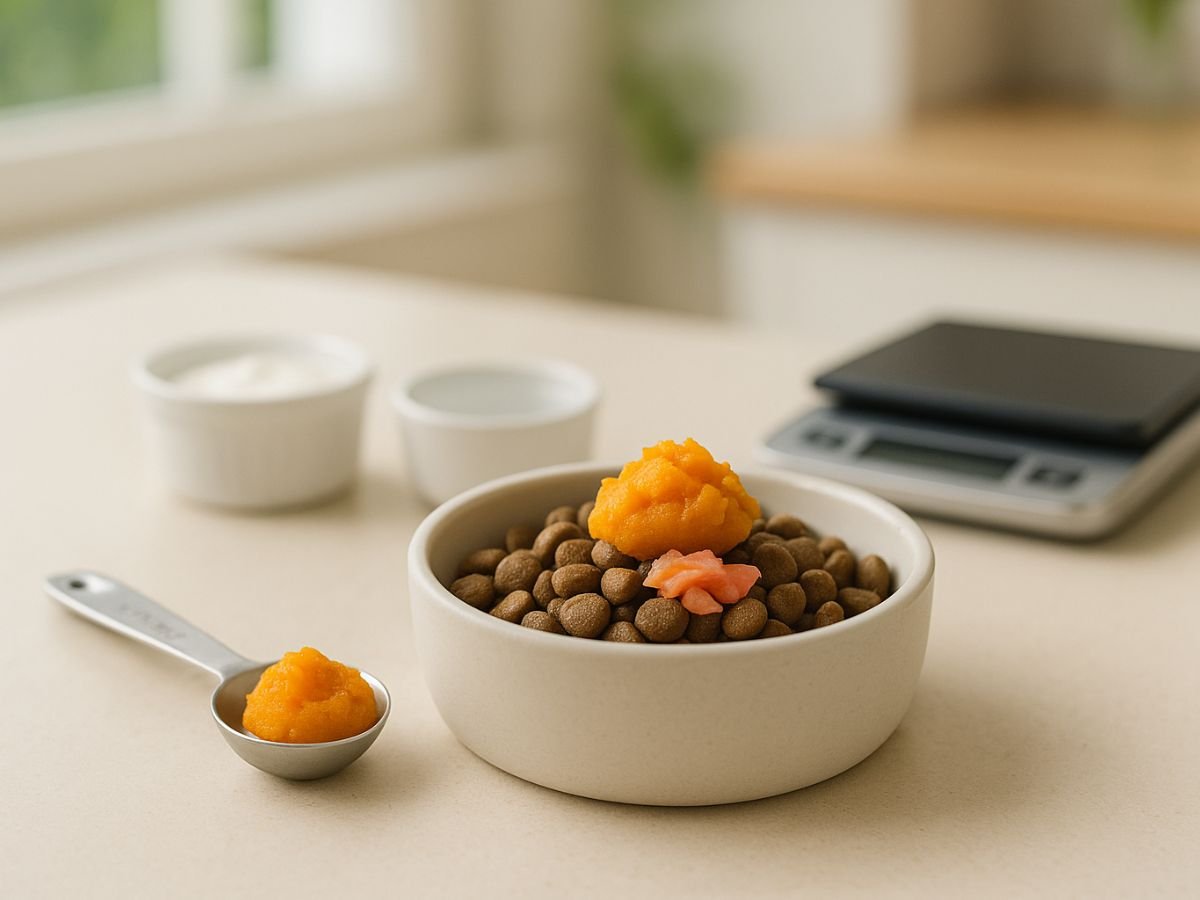Small Dog Nutrition 101: The Real‑World Guide for Tiny Tummies
The 3 Outcomes You’ll Get Here
This guide follows veterinary‑aligned sources (WSAVA, AAHA, Tufts) and my tested method—practical, no fluff.Monty, my stubborn‑but‑loveable Westie, was the original R&D department—he approves of anything that fixes itch, poop, and peace at 8pm.
- Itch relief (fewer flare‑ups, calmer skin).
- Better poops (firm, consistent, less… let’s say dramatic).
- Calmer evenings (steady energy, fewer zoomies-from-nowhere).
Small dogs have tiny calorie budgets. That means small tweaks move mountains. This small dog nutrition guide shows you the fuss‑free tweaks that work.
TL;DR (What This Is + How To Use It)
- Who it’s for: Small‑dog parents (≤25 lb)
- What you’ll get: Quick toppers, label basics, precise portions, 5‑step plan, budget table, troubleshooting.
- How to use it: 1) Do Section 1 tonight. 2) Read Section 2 once. 3) Follow Section 3 for 30 days. 4) Choose foods by cost/day in Section 4. 5) Fix issues with Section 5.
Quick Wins: Freshen the Bowl (Tonight)
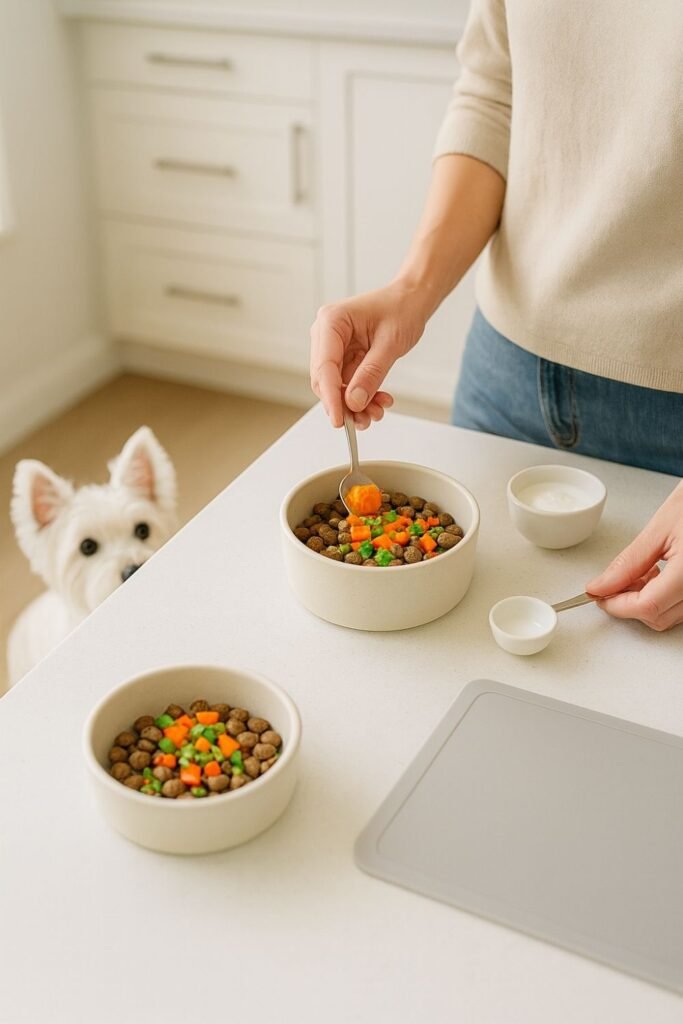
Exact amounts at a glance (measure with teaspoons):
| Dog weight | Kefir/Yogurt (plain) | Pumpkin (plain, canned) | Omega‑3 EPA+DHA (mg/day)* |
|---|---|---|---|
| 5 lb | ½–1 tsp | ½–1 tsp | ~45–90 mg |
| 10 lb | 1–2 tsp | 1–2 tsp | ~90–180 mg |
| 15 lb | 1½–2½ tsp | 1–2 tsp | ~135–270 mg |
| 20 lb | 2–3 tsp | 1½–2½ tsp | ~180–360 mg |
*Dose fish oil by EPA+DHA combined; start low and stay within the 10%‑of‑daily‑calories rule.
Do Not Use (safety): xylitol, grapes/raisins, onions/garlic, cooked bones, high‑fat scraps. When in doubt, skip it and check the ASPCA Poison Control guidance.
Goal: Add nutrition without unbalancing the diet or inflating calories.
Rules of thumb
- Treats/toppers ≤ 10% of daily calories. For a 10‑lb dog, that’s roughly 30 kcal/day for extras. Tiny dogs topple balance quickly—measure!
- Start low. If stool loosens, halve the amount or pause.
Topper ideas that actually help
- Omega‑3 (fish oil): Start ~20–40 mg/kg EPA+DHA per day. Go low and build; use a product listing EPA+DHA per pump/capsule. Avoid cod liver oil (vitamin A/D overload risk).
- Plain kefir or live‑culture yogurt (unsweetened): 1–2 tsp for 10‑lb dogs. Watch tolerance (some are dairy‑sensitive).
- Canned plain pumpkin: 1–2 tsp; can help stool quality (too much may constipate).
- Hydration boost: Warm water or low‑sodium broth splash over kibble; improves aroma and chewability for tiny mouths.
- Lean protein sprinkles: A few bites of plain cooked salmon, turkey, or egg. Keep within the 10% cap.
- Joint-friendly topper (small seniors): pair fish oil (~20–40 mg/kg EPA+DHA; start low) with a turmeric-free joint chew sized for small dogs (glucosamine/chondroitin/GLM/MSM/HA or UC-II). Keep within your 10% treat cap and introduce one change at a time.
Skip/avoid
- Xylitol, grapes/raisins, onions/garlic, high‑fat scraps, cooked bones. If in doubt, don’t.
Mini script for tonight
- Weigh your dog.
- Pick one topper from the list.
- Measure it (use teaspoons, not vibes).
- Note poop tomorrow using the Poop Scorecard (see below).
Core Concepts: Labels & Calories Made Simple
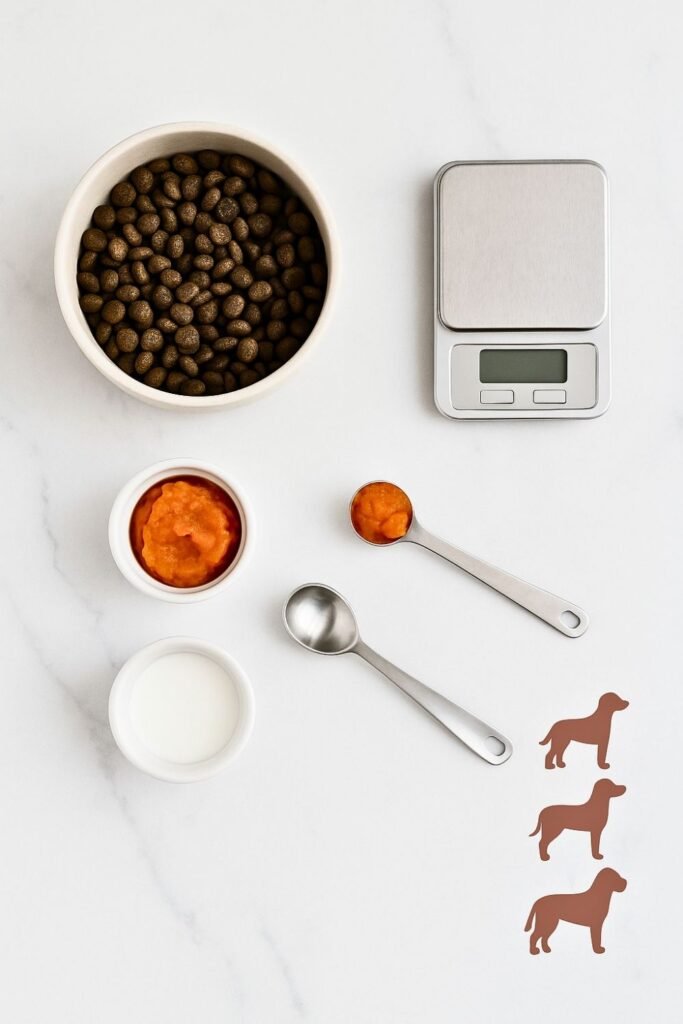
Worked example: A 10‑lb dog needs ~250 kcal/day. If a kibble provides 360 kcal/cup, feed about 0.7 cup/day, split into 2 meals (~0.35 cup each). Adjust portions ±10–15% based on Body Condition Score (BCS) and stool.
Quick visual aids :
- AAFCO statement: the meaning of Complete & Balanced for Adult Maintenance ”

- BCS reference: WSAVA 1–9 BCS chart for dogs PDF or see video for quick visual
The 60‑second label check
- AAFCO statement: Look for “complete & balanced” for your dog’s life stage (adult/puppy/all life stages).
- Calories: Find kcal per cup/can; small dogs need consistent portions.
- Company quality: Do they have a vet nutritionist? Feeding trials? Contact info?
Ingredient list reality check
- Ingredients are listed by weight pre‑cooking—fresh meats look great but lose water; don’t judge quality by poetry.
- “Intermittent or supplemental feeding” = not a main diet.
Nutrition disclaimer: If your dog’s main diet is not labeled “Complete & Balanced” for their life stage per AAFCO, you’ll need a veterinary-approved balancing supplement or a formulated recipe from a board-certified veterinary nutritionist. “Intermittent or supplemental feeding” products (and most DIY/home-cooked routines) do not meet full micronutrient needs on their own. Don’t try to “wing it” with a multivitamin—doses and nutrient ratios matter at small-dog bodyweights. When in doubt, ask your veterinarian or a DACVN/ECVCN nutritionist to review your plan.
How many calories per day?
- A tidy starting point for a healthy 10‑lb (4.5 kg) adult: roughly 220–300 kcal/day. Activity, age, and metabolism vary—use Body Condition Score (BCS) to dial it in.
Portioning
- Split daily calories into 2 meals for most small dogs. Tiny toy breeds may prefer 3 mini meals.
- Change amounts by 10–15% and hold for 7 days, watching BCS and poop.
Your 5‑Step Plan: FURST
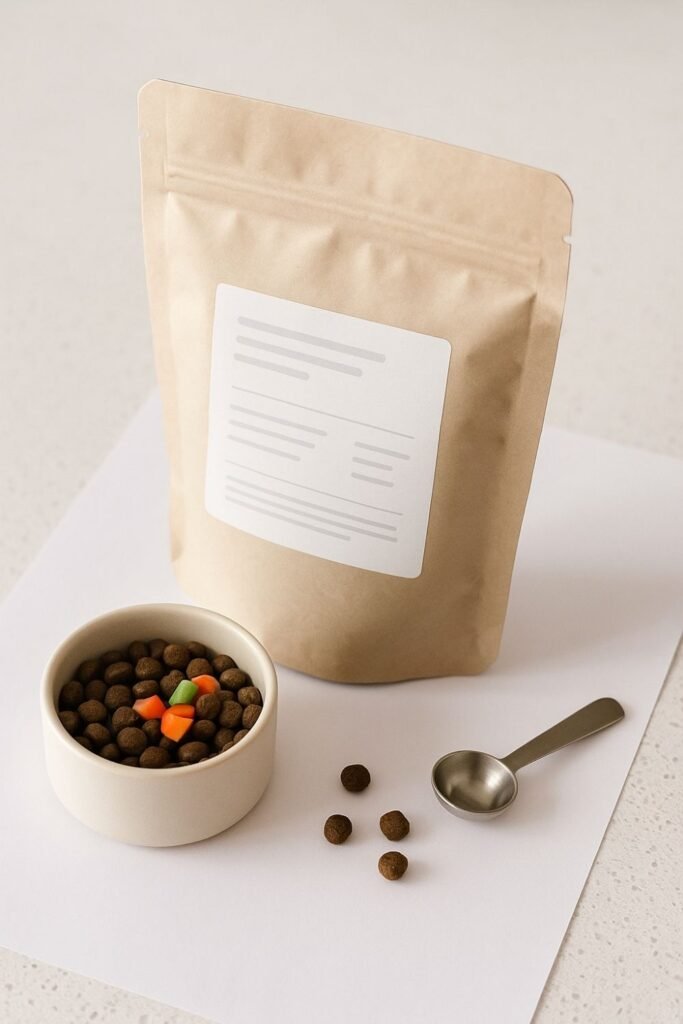
F – Freshen the bowl (daily toppers)
- Use the Quick Wins list. Stay within the 10% rule. Rotate toppers across the week.
U – Upgrade the base
- Keep it complete & balanced. If changing brands, transition over 7–10 days (25% → 50% → 75% → 100%).
- If your dog has a history of pancreatitis or food reactions, consult your vet before switching.
R – Rotate proteins/brands (quarterly)
- Variety is enrichment. Rotate every 3 months — pause rotation during elimination diets.
- Always transition slowly; log stool and skin.
S – Supplement smart
- Omega‑3 (EPA+DHA): start low; measure; note coat/itch/poop changes (dose by EPA+DHA mg/kg; start low).
- Probiotic: pick a product with listed CFUs/strain (e.g., L. rhamnosus GG); try 2–4 weeks and score poop.
- Joint (seniors/toy breeds with knee quirks): discuss with your vet for dosing and interactions.
T – Track
- Use the Poop Scorecard (1–5 scale), BCS chart (1–9), and a 30‑day mini log. Snap weekly photos in the same spot/light.
Your 7‑Day Food Upgrade Challenge (single‑page table)
Prefer the printable? Grab it in the kit below.
| ✓ | Day | Task | What I’ll Do |
| [ ] | 1 | Hydration boost | Warm water/low‑sodium broth splash on meals |
| [ ] | 2 | Portion check | Re‑calc kcal/day; weigh food; split into 2–3 meals |
| [ ] | 3 | Probiotic start | Begin vetted probiotic or 1–2 tsp plain kefir/yogurt |
| [ ] | 4 | Omega‑3 intro | Start EPA+DHA dose; note brand + mg given |
| [ ] | 5 | Fiber/protein nudge | 1–2 tsp plain pumpkin or a few bites lean protein |
| [ ] | 6 | Treat audit | Cap treats at ≤10% kcal; swap in low‑cal options |
| [ ] | 7 | Review & adjust | Check BCS + stool; tweak portions ±10% |
Budget Feeding Without Compromise (Good/Better/Best)
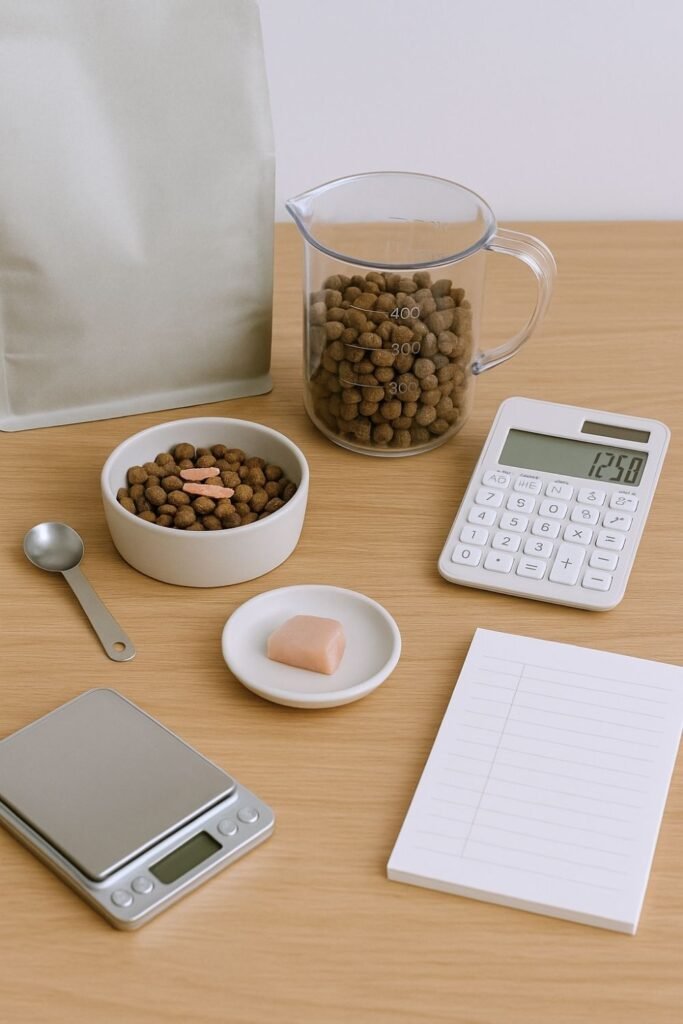
Compare by cost‑to‑feed ($/day), not bag price. Use your dog’s daily kcal and the bag’s kcal/cup.
Worked example (10‑lb dog): Needs ~250 kcal/day. If a food is 360 kcal/cup, that’s 0.7 cup/day. If a 12‑lb bag costs $36 and ≈ 48 cups (≈4 cups/lb), bag kcal = 360×48 = 17,280.
Cost/day = $36 ÷ 17,280 × 250 ≈ $0.52/day.
Tier framework (brand‑agnostic):
| Tier | What it looks like |
| Good | Complete & balanced adult small‑breed kibble meeting AAFCO; responsive support; clear kcal/cup |
| Better | Above + named animal protein lead; strong QA/QC; feeding trials |
| Best | Above + vet‑nutritionist involvement; strong digestibility data; options for sensitivities |
Anonymized sample (10‑lb dog, ~250 kcal/day)
| Brand (anon) | Bag (lb) | Price $ | kcal/cup | Cups/bag | Bag kcal | $/day |
| A (Good) | 12 | 36 | 360 | 48 | 17,280 | 0.52 |
| B (Better) | 4 | 20 | 400 | 16 | 6,400 | 0.78 |
| C (Best) | 10 | 65 | 420 | 40 | 16,800 | 0.97 |
Stretch‑the‑budget tricks
- Buy the right bag size (bigger isn’t better if it goes stale).
- Use airtight storage; finish within 4–6 weeks of opening.
- Spend on the base diet first, then add budget‑friendly toppers.
Troubleshooting Toolkit
Access the additional resources here: Small Dog Nutrition Printable Kit
A) Poop Scorecard (stool quality)
- Goal: consistently formed logs (not marbles, not soft‑serve).
- If stool loosens after a change: pause new topper, reduce portion size by 10%, and give 48–72 hours.
- Persistent diarrhea, blood, lethargy, weight loss = vet visit.
B) Itchy‑Skin Flow (30‑day mini plan)
- Start omega‑3; log itch/scratch areas weekly.
- Simplify diet (one base food + 10%‑rule toppers only).
- If no improvement by week 3–4, ask your vet about an elimination diet (8+ weeks; no flavored meds/treats).
- Medicated baths and environmental cleaning can help; diet isn’t the only lever.
C) Blending Fresh with Kibble (safely)
- Keep fresh foods within 10% until you’ve proven tolerance.
- For raw diets: follow strict hygiene; consider risks (humans in the home, immunocompromised folks, kids). If you go raw, do it with veterinary guidance.
D) DCM (diet‑associated heart disease) — the calm summary
- Research is ongoing; no single villain ingredient. Be cautious with boutique/exotic/legume‑heavy patterns. Choose makers with strong nutrition staff and QA, and talk to your vet if worried.
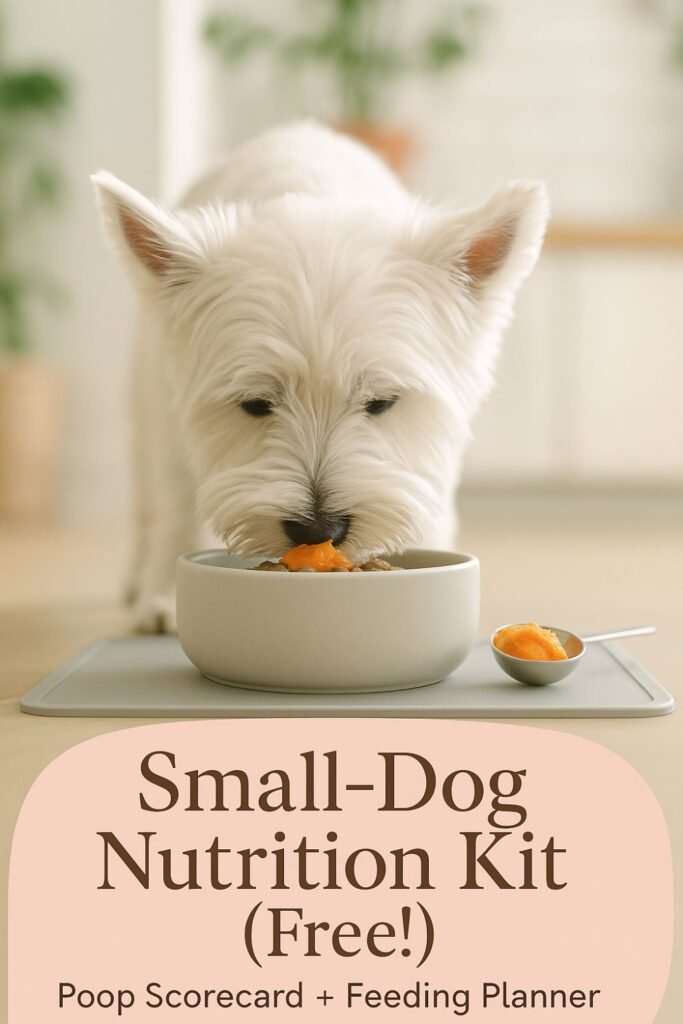
For more ideas on dog food, see our post 25 Easy & Healthy Homemade Dog Treats, and browse our dog treats category.
FAQ’s About Small Dog Nutrition
1. Do small dogs really need “small‑breed” formulas?
Not always, but tiny mouths and higher metabolic rates benefit from higher kcal/cup and smaller kibble. If your dog chews comfortably and holds weight well, a regular adult formula may be fine.
2. Is grain‑free better?
Not by default. Pick complete & balanced diets from manufacturers with robust nutrition teams. If your vet suspects a grain allergy, follow their guidance.
3. Can I rotate foods to prevent allergies?
Rotation is great for enrichment and palatability, but it doesn’t “vaccinate” against allergies. Pause rotation if you begin an elimination diet.
4. How many treats can my tiny dog have?
Use the 10% rule. For a 10‑lb dog, keep extras around 30 kcal/day max.
5. My dog’s poop got soft when I added toppers. Now what?
Roll back the new topper, reduce total calories by ~10%, and reassess in 48–72 hours. If symptoms persist or you see blood/mucus, call your vet.
6. Do probiotics actually help?
Many dogs benefit during transitions or after tummy upsets. Choose products with named strains and CFUs on the label; trial for 2–4 weeks.
7. Is raw feeding safe?
There are handling risks to people and pets. If you choose raw, use strict hygiene and work with a vet professional.

